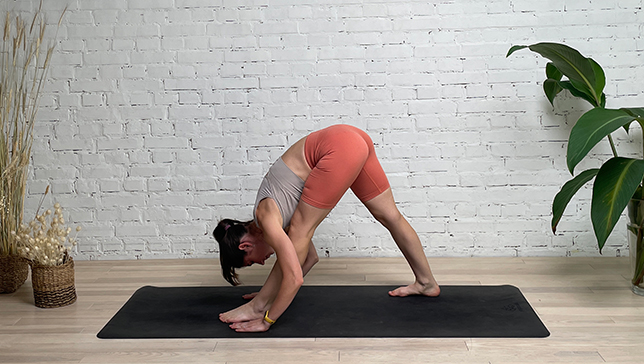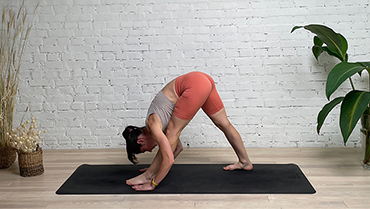Pyramid Pose

Contents
Pyramid Pose, Intense Side Stretch Pose or Parsvottanasana in Sanskrit (‘Parsva’ means ‘Side’, ‘Ut’ means ‘intense’ and ‘tan’ means to ‘extend, stretch or lengthen’) is an intermediate-level standing posture that involves a deep forward fold that helps to stretch hip muscles and hamstrings and lengthen the spine.
Assuming Pyramid Pose requires aligning both the heels sidewise separating the legs and joining the hands in reverse prayer pose or simply placing them on the mat in one line with the leg that goes forward. This is followed by bending the torso so that the head touches the shin of the front leg.
Pose Detail
- By Type: Flexibility Yoga Poses
- Body Position: Forward Bend Yoga Poses, Inversion Yoga Poses, Standing Yoga Poses
- Difficulty: Intermediate
- By Benefit: Yoga Poses For Digestion, Yoga Poses For Weight Loss
Step-by-Step Instructions
Benefits and Contraindications
Calms the brain and flush the sinuses with mild inversion.
Stretches the spine, hip muscles and hamstrings
Strengthens the legs and spine.
Improves posture.
Aids digestion.
Elongates hamstrings.
Recent back surgery
High or low blood pressure.
Migraine
Low back pathologies.
Ankle, knee, or hip injury.
Shoulder injury (if taking hands behind the back)
Photo poses in different angles


Modifications, Props and Tips
Parsvottanasana will challenge your balance, serenity, and flexibility when practiced in correct alignment. Keep the following information in mind when practicing this pose:
- Keep your hips squared throughout the pose.
- Lengthen the front of your torso from your breast bone to your navel.
- Keep the crown of your head reaching forward as you simultaneously extend your tailbone behind you.
- Use yoga blocks if you can not reach the floor with your spine straight
- Use a yoga strap if you can not clasp your hands behind your back
- Beginners also find it difficult to maintain the firmness of the back leg. To attain the stretch fully with the leg and inner groin softening the front knee will be helpful.
Frequently Asked Questions
Modifications & Variations
- Pyramid Pose Hands On Blocks
- Pyramid Pose Hands in Reverse Prayer Pose
- Pyramid Pose With A Front Knee Slightly Bent
- Pyramid Pose with Torso Parallel to the Ground
Top Preparatory Poses
Top Follow-Up Poses
- Triangle Pose
- Warrior Pose II
- Extended Side Angle Pose
- Half Splits Pose